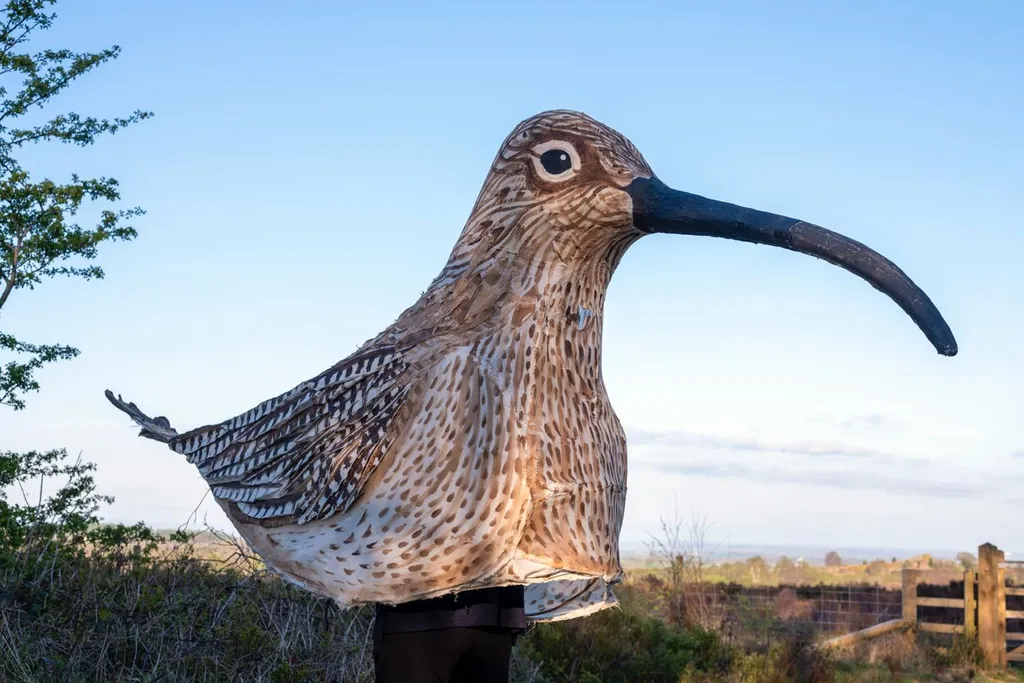
WWW.SMITHSONIANMAG.COM
A U.K. Man Just Walked 53 Miles Wearing a Giant, Handmade Bird Costume. Here's Why He Did It
A U.K. Man Just Walked 53 Miles Wearing a Giant, Handmade Bird Costume. Here’s Why He Did It
As he trekked across the English countryside, 46-year-old Matt Trevelyan caused quite a stir with his attention-grabbing outfit
Trevelyan is a former puppet maker, so making the curlew costume was relatively easy for him.
Tessa Bunney
Residents of northern England did a double take when they spotted an unusually large bird wandering around the countryside last weekend. Measuring ten feet long from beak tip to tail, the enormous creature had a long, slender bill and big brown eyes.
“We saw him pass by our field this morning,” one resident wrote on Facebook on Sunday. “Was a bit of a shock.”
But the eye-catching bird wasn’t some new, super-sized species. It was a man dressed in costume, trekking conspicuously to raise awareness about the plight of one of the United Kingdom’s most iconic and threatened birds.
Matt Trevelyan walked 53 miles in total along a route called the Nidderdale Way—all while wearing a handmade outfit designed to look like a Eurasian curlew, the largest wading bird in Europe. He spent three days creating the costume out of split bamboo, muslin and polystyrene. Trevelyan nicknamed his creation “Cathy.”
On April 19, the 46-year-old set off on foot from Pateley Bridge, a small town in North Yorkshire, England. He walked 25 miles before calling it quits for the day.
The next morning, he woke up and trekked another 28 miles, alternating between running and walking. He could see where he was going by looking through a peephole in the costume’s neck.
“The costume was fairly easy to walk in,” he tells the Yorkshire Post’s Charlie Fenton. “As long as I pointed the beak in the correct direction and ducked underneath the occasional branch, I was fine.”Trevelyan works for Nidderdale National Landscape, a 233-square-mile protected natural area that’s similar to a national park. He supports farmers and landowners who live within the national landscape in his role as a “farming in protected landscapes” officer.
Earlier in his career, however, he worked as a puppet maker, so constructing the costume was relatively easy for him. But Trevelyan wanted to make sure his life-sized curlew was perfect before setting off.
“I wanted to represent curlews well, because they’re such a beautiful bird,” he tells BBC News’ Grace Wood and Kat Cowan.
Trevelyan dreamed up the scheme as a way to call attention to the Eurasian curlew (Numenius arquata), which is threatened by land-use changes, habitat loss, predators and climate change.
He was inspired by Mary Colwell, a conservationist and author who walked roughly 500 miles across the British Isles in 2016 to learn more and raise awareness about the curlew’s decline. Colwell wrote a book about her pilgrimage called Curlew Moon. She also formed Curlew Action, a charity that aims to protect the birds from extinction, and established World Curlew Day, held every year on April 21. Trevelyan timed his walk to align with World Curlew Day.
Trevelyan walked 25 miles one day, then 28 miles the next—all while wearing the costume.
Alex Ward
Eurasian curlews are large, mottled brown birds with long legs and distinctive downward-curving beaks, which they use like tweezers to forage through mud for insects, worms, crustaceans and mollusks.
Thousands of the leggy birds return to England’s moors and grasslands each spring to breed. But their eggs and hatchlings can get crushed by tractors; they’re also being eaten by foxes, crows and sheep.
If young curlews cannot survive to reproductive age, conservationists fear there won’t be enough breeding birds to replenish the species’ numbers, which could cause the entire population to collapse.
“We need something like 10,000 more curlews a year to become a sustainable population,” Trevelyan tells the Independent’s Bryony Gooch. “We need curlews to be fledging one chick every two years, and they lay four eggs a year that generally don’t fledge any chicks. … One chick every other year. That’s all we need to have a sustainable population, but we’re a long way off that.”
Eurasian curlews are Europe's largest wading bird.
Jo Wright
Since 2015, the birds have been listed on the U.K.’s “red list” for threatened species of the highest conservation priority. The International Union for Conservation of Nature (IUCN) lists them as “near threatened” throughout Europe.
Over the last 25 years, the U.K.’s curlew population has declined by 48 percent, according to a recent statement from Nidderdale National Landscape. Ireland now has just 150 nesting pairs, down from 150,000 in the 1960s. And, in Wales, experts say breeding populations of the birds are on track to disappear entirely by 2033.
But organizations like Nidderdale National Landscape are working to reverse the trend. With his attention-grabbing walk, Trevelyan also wanted to raise money for local curlew conservation projects and encourage residents to get involved in looking out for the birds.
“Many farmers already take steps to protect nests—cutting around them, delaying mowing or checking fields for chicks,” Trevelyan says in the statement. “However, not all land managers are aware of the curlew’s red-listed status or what they can do to help.”
Get the latest stories in your inbox every weekday.
0 التعليقات
0 المشاركات
27 مشاهدة


